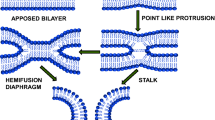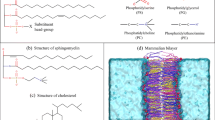Abstract
We investigated the interaction of six 18-residue peptides derived from amphipathic helical segments of globular proteins with model membranes. The net charge of the peptides at neutral pH varies from −1 to +6. Circular dichroism spectra indicate that peptides with a high net positive charge tend to fold into a helical conformation in the presence of negatively charged lipid vesicles. In helical conformation, their average hydrophobic moment and hydrophobicity would render them surface-active. The composition of amino acids on the polar face of the helix in the peptides is considerably different. The peptides show variations in their ability to permeabilise zwitterionic and anionic lipid vesicles. Whereas increased net positive charge favours greater permeabilisation, the distribution of charged residues in the polar face also plays a role in determining membrane activity. The distribution of amino acids in the polar face of the helix in the peptides that were investigated do not fall into the canonical classes described. Amphipathic helices, which are part of proteins, with a pattern of amino acid distribution different from those observed in class L, A and others, could help in providing newer insights into peptide-membrane interactions.
Similar content being viewed by others
Abbreviations
- CD:
-
circular dichroism
- HPLC:
-
high-performance liquid chromatography
- LUV:
-
large unilamellar vesicles
- MRE:
-
mean residue ellipticity
- naf:
-
normal accessibility factor
- NBS:
-
N-bromosuccinimide
- PC:
-
1-palmitoyl-2-oleoyl-sn-glycerophosphocholine
- PDB:
-
Protein Data Bank
- PG:
-
1-palmitoyl-2-oleoyl-sn-glycerophosphoglycerol
- P/L:
-
peptide:lipid
- SUV:
-
small unilamellar vesicles
References
Agawa Y, Lee S, Ono S, Aoyagi H, Ohno M, Taniguchi T, Anzai K and Kirino Y 1991 Interaction with phospholipid bilayers, ion channel formation, and antimicrobial activity of basic amphipathic alpha-helical model peptides of various chain lengths; J. Biol. Chem. 266 20218–20222
Arbuzova A and Schwarz G 1999 Pore-forming action of mastoparan peptides on liposomes: a quantitative analysis; Biochim. Biophys. Acta 1420 139–152
Atherton E and Sheppard R C 1989 Solid phase synthesis. A practical approach (Oxford: IRL press)
Benachir T and Lafleur M 1995 Study of vesicle leakage induced by melittin; Biochim. Biophys. Acta 1235 452–460
Blondelle S E and Houghten R A 1992 Design of model amphipathic peptides having potent antimicrobial activities; Biochemistry 31 12688–12694
Cornell R B and Taneva S G 2006 Amphipathic helices as mediators of the membrane interaction of amphitropic proteins, and as modulators of bilayer physical properties; Curr. Protein Pept. Sci. 6 539–552
Dathe M, Schumann M, Wieprecht T, Winkler A, Beyermann M, Krause E, Matsuzaki K, Murase O and Bienert M 1996 Peptide helicity and membrane surface charge modulate the balance of electrostatic and hydrophobic interactions with lipid bilayers and biological membranes; Biochemistry 35 12612–12622
Degrado W F, Kezdy F J and Kaiser E T 1981 Design, synthesis and characterization of a cytotoxic peptide with melittin-like activity; J. Am. Chem. Soc. 103 679–681
Dempsey C E 1990 The actions of melittin on membranes; Biochim. Biophys. Acta 1031 143–161
Eisenberg D, Weiss R M and Terwilliger T C 1982a The helical hydrophobic moment: a measure of amphiphilicity of a helix; Nature (London) 299 371–374
Eisenberg D, Weiss R M, Terwilliger T C and Wilcox W 1982b Hydrophobic moments and protein structure; Faraday Symp. Chem. Soc. 17 109–120
Epand R M, Shai Y, Segrest J P and Anantharamiah G M 1995 Mechanisms for the modulation of membrane bilayer properties by amphipathic helical peptides; Biopolymers 37 319–338
Fernandez-Vidal M, Jayasinghe S, Ladokhin A S and White S H 2007 Folding amphipathic helices into membranes: amphiphilicity trumps hydrophobicity; J. Mol. Biol. 370 459–470
Giangaspero A, Sandri L and Tossi A 2001 Amphipathic α-helical antimicrobial peptides; Eur. J. Biochem. 268 5589–5600
Huang E S, Subbiah S and Levitt M 1995 Recognizing native folds by the arrangement of hydrophobic and polar residues; J. Mol. Biol. 252 709–720
Johnson J E and Cornell R B 1999 Amphitropic proteins: regulation by reversible membrane interactions; Mol. Membr. Biol. 16 217–235
Kaiser E T and Kezdy F J 1984 Amphiphilic secondary structure: design of peptide hormones; Science 223 249–255
Kaiser E T and Kezdy F J 1987 Peptides with affinity for membranes; Ann. Rev. Biophys. Biophyschem. 16 561–581
Kiyota T, Lee S and Sugihara G 1996 Design and synthesis of amphiphilic alpha-helical model peptides with systematically varied hydrophobic-hydrophilic balance and their interaction with lipid- and bio-membranes; Biochemistry 35 13196–13204
Ladokhin A S and White S H 1999 Folding of Amphipathic α-helices on membranes: energetics of helix formation by melittin; J. Mol. Biol. 285 1363–1369
Ladokhin A S and White S H 2001 ’Detergent-like’ permeabilization of anionic lipid vesicles by melittin; Biochim. Biophys. Acta 1514 253–260
MacDonald R C, MacDonald R I, Menco B P, Takeshita K, Subbarao N K and Hu L R 1991 Small-volume extrusion apparatus for preparation of large, unilamellar vesicles; Biochim. Biophys. Acta 1061 297–303
Maloy W L and Kari U P 1995 Structure-activity studies on magainins and other host defense peptides; Biopolymers 37 105–122
Manning M C, Illangasekare M and Woody R W 1988 Circular dichroism studies of distorted alpha-helices, twisted beta-sheets, and beta-turns; Biophys. Chem. 31 77–86
Matsuzaki K 1998 Magainins as paradigm for the mode of action of pore-forming polypeptides; Biochim. Biophys. Acta 1376 391–400
Matsuzaki K 1999 Why and how are peptide-lipid interactions utilized for self-defense? Magainins and tachyplesins as archetypes; Biochim. Biophys. Acta 1462 1–10
Oren Z and Shai Y 1998 Mode of action of linear amphipathic alpha-helical antimicrobial peptides; Biopolymers 47 451–463
Phoenix D A, Stanworth A and Harris F 1998 The hydrophobic moment plot and its efficacy in the prediction and classification of membrane-interactive proteins and peptides; Membr. Cell Biol. 12 101–110
Phoenix D A and Harris F 2002 The hydrophobic moment and its use in the classification of amphiphilic structures; Mol. Membr. Biol. 19 1–10
Raghuraman H and Chattopadhyay A 2007 Melittin: a membrane-active peptide with diverse functions; Biosci. Rep. 27 189–223
Ramamoorthy A, Thennarasu S, Lee D, Tan A and Maloy L 2006 Solid-state NMR investigation of the membranedisrupting mechanism of antimicrobial peptides MSI-78 and MSI-594 derived from magainin 2 and melittin; Biophys. J. 91 206–216
Saberwal G and Nagaraj R 1994 Cell-lytic and antibacterial peptides that act by perturbing the barrier function of membranes: facets of their conformational features, structure-function correlations and membrane-perturbing abilities; Biochim. Biophys. Acta 11 109–131
Schwarz G and Arbuzova A 1995 Pore kinetics reflected in the dequenching of a lipid vesicle entrapped fluorescent dye; Biochim. Biophys. Acta 1239 51–57
Segrest J P, Jackson R L, Morrisett J D and Gotto A M Jr 1974 A molecular theory of lipid-protein interactions in the plasma lipoproteins; FEBS Lett. 38 247–258
Segrest J P, DeLoff H, Dohlman J G, Brouillette C G and Anantharamiah G M 1990 Amphipathic helix motif: classes and properties; Proteins Struct. Funct. Genet. 8 103–117
Shai Y 1999 Mechanism of the binding, insertion and destabilization of phospholipid bilayer membranes by α-helical antimicrobial and cell non-selective membrane-lytic peptides; Biochim. Biophys. Acta 1462 55–70
Sharadadevi A, Sivakamasundari C and Nagaraj R 2005 Amphipathic alpha helices in proteins: results from analysis of protein structures; Proteins 59 791–801
Sims P J, Waggoner A S, Wang C-H and Hoffman J C 1974 Studies on the mechanism by which cyanine dyes measure membrane potential in red blood cells and phosphatidylcholine vesicles; Biochemistry 13 3315–3330
Sitaram N and Nagaraj R 1999 Interaction of antimicrobial peptides with biological and model membranes: structural and charge requirements for activity; Biochim. Biophys. Acta 1462 29–54
Tossi A, Sandri L and Giangaspero A 2000 Amphipathic alphahelical antimicrobial peptides; Biopolymers 55 4–30
Uematsu N and Matsuzaki K 2000 Polar angle as a determinant of amphipathic alpha-helix-lipid interactions: a model peptide study; Biophys. J. 79 2075–2083
Venyaminov S Y and Yang J T 1996 Determination of protein secondary structure: in Circular dichroism and the conformational analysis of biomolecules (ed.) G D Fasman (New York: Plenum Press) pp 69–107
Wieprecht T, Dathe M, Epand R M, Beyermann M, Krause E, Maloy W L, MacDonald D L and Bienert M 1997a Influence of the angle subtended by the positively charged helix face on the membrane activity of amphipathic, antibacterial peptides; Biochemistry 36 12869–12880
Wieprecht T, Dathe M, Beyermann M, Krause E, Maloy W L, MacDonald D L and Bienert M 1997b Peptide hydrophobicity controls the activity and selectivity of magainin 2 amide in interaction with membranes; Biochemistry 36 6124–6132
Woody R W 1995 Circular dichroism; Methods Enzymol. 246 34–71
Author information
Authors and Affiliations
Corresponding author
Rights and permissions
About this article
Cite this article
Sivakamasundari, C., Nagaraj, R. Interaction of 18-residue peptides derived from amphipathic helical segments of globular proteins with model membranes. J Biosci 34, 239–250 (2009). https://doi.org/10.1007/s12038-009-0028-0
Received:
Accepted:
Published:
Issue Date:
DOI: https://doi.org/10.1007/s12038-009-0028-0




